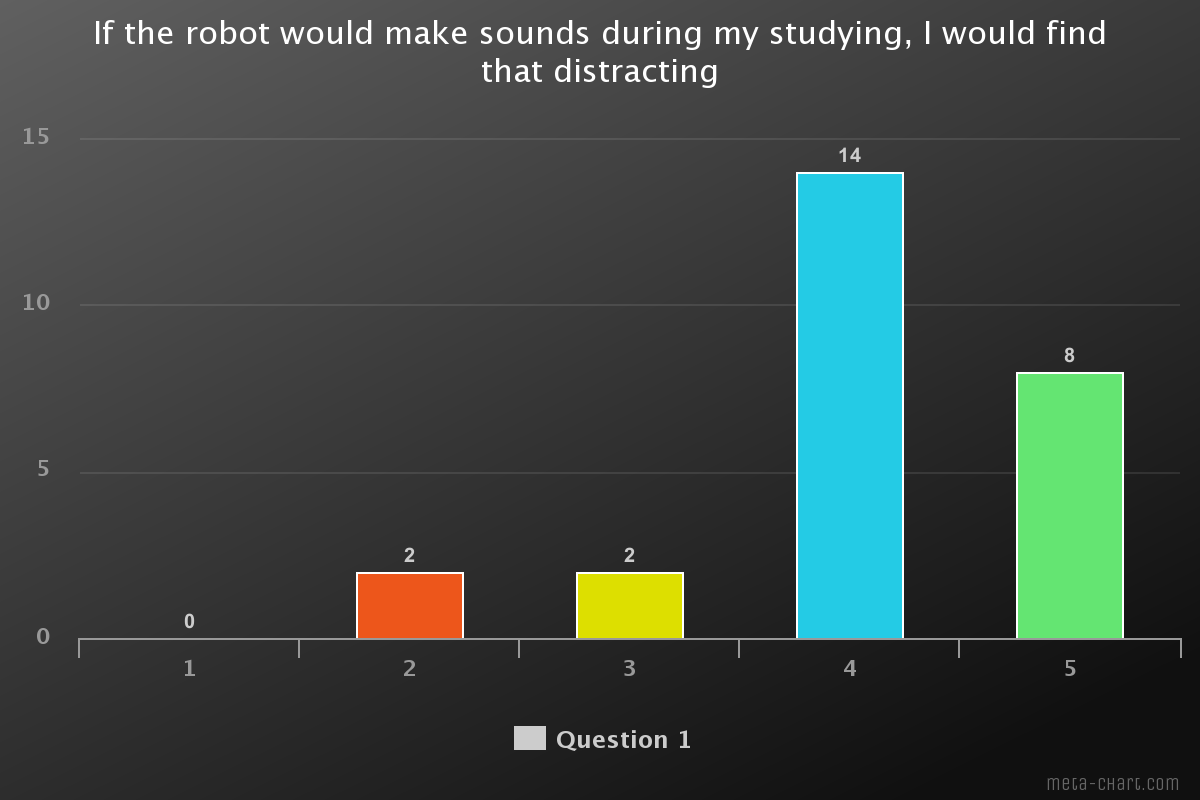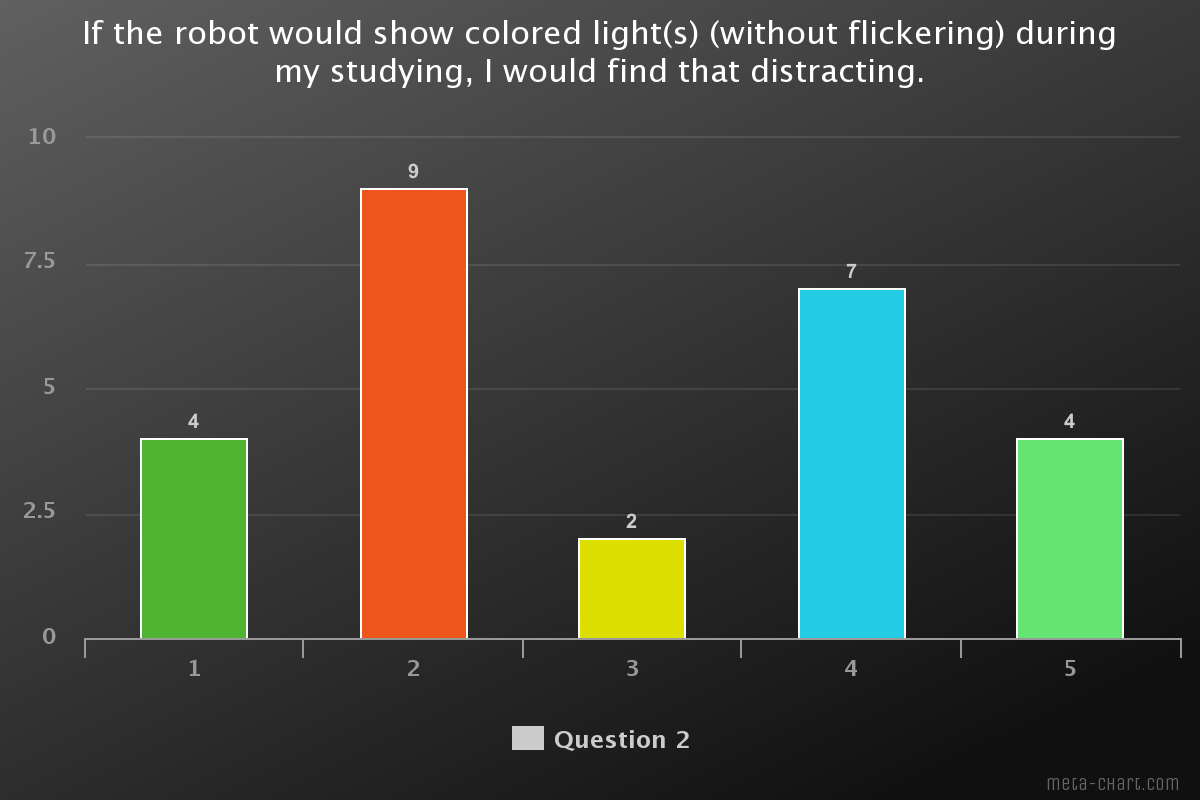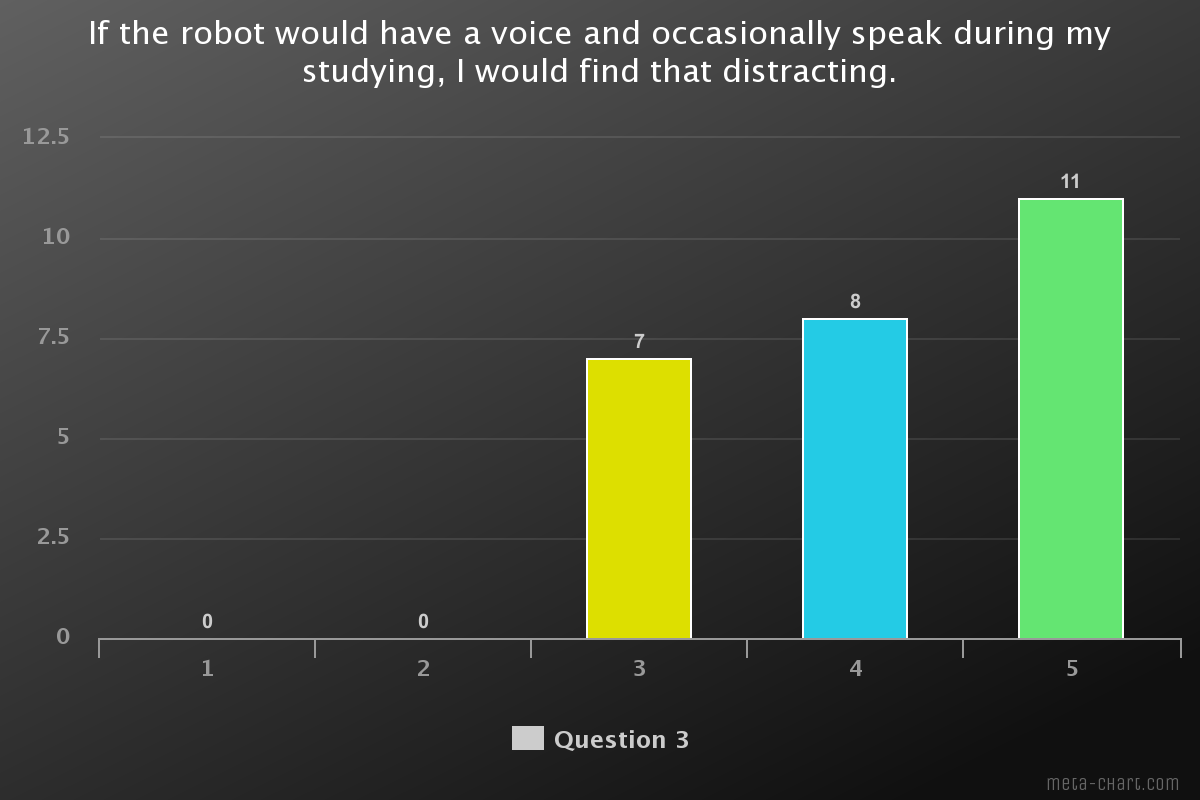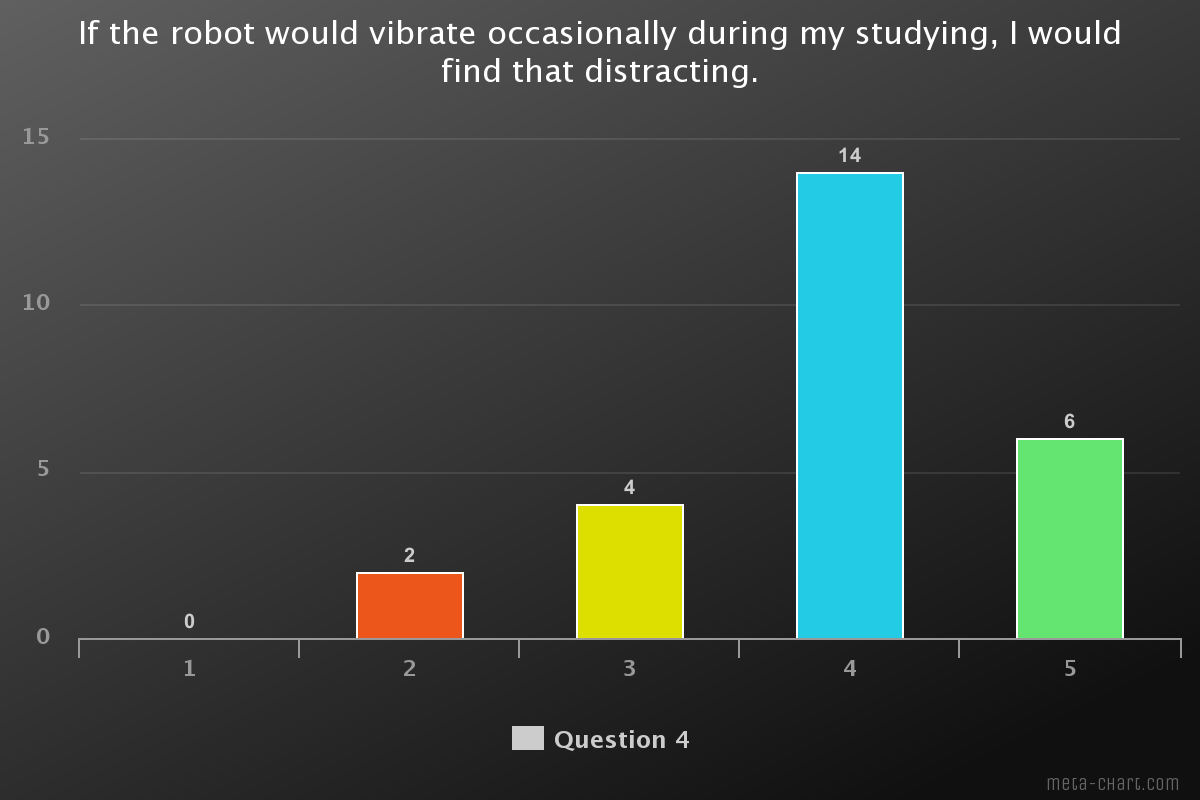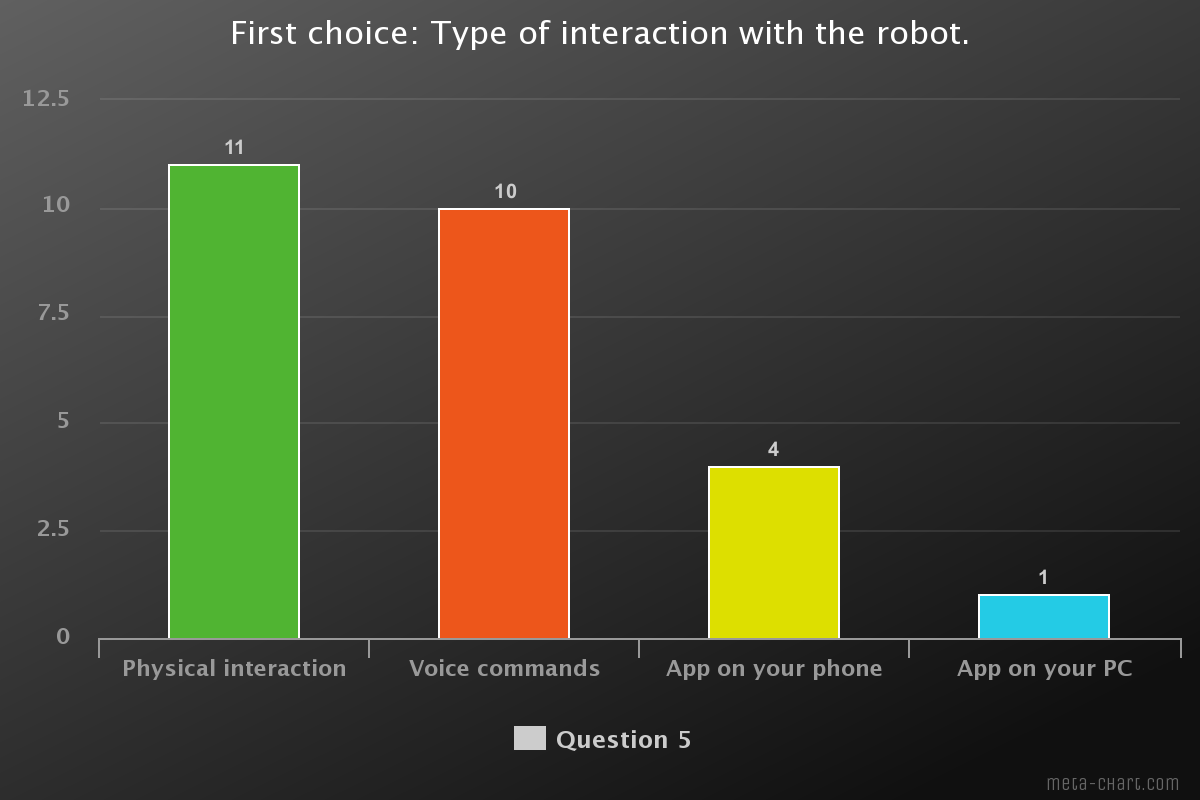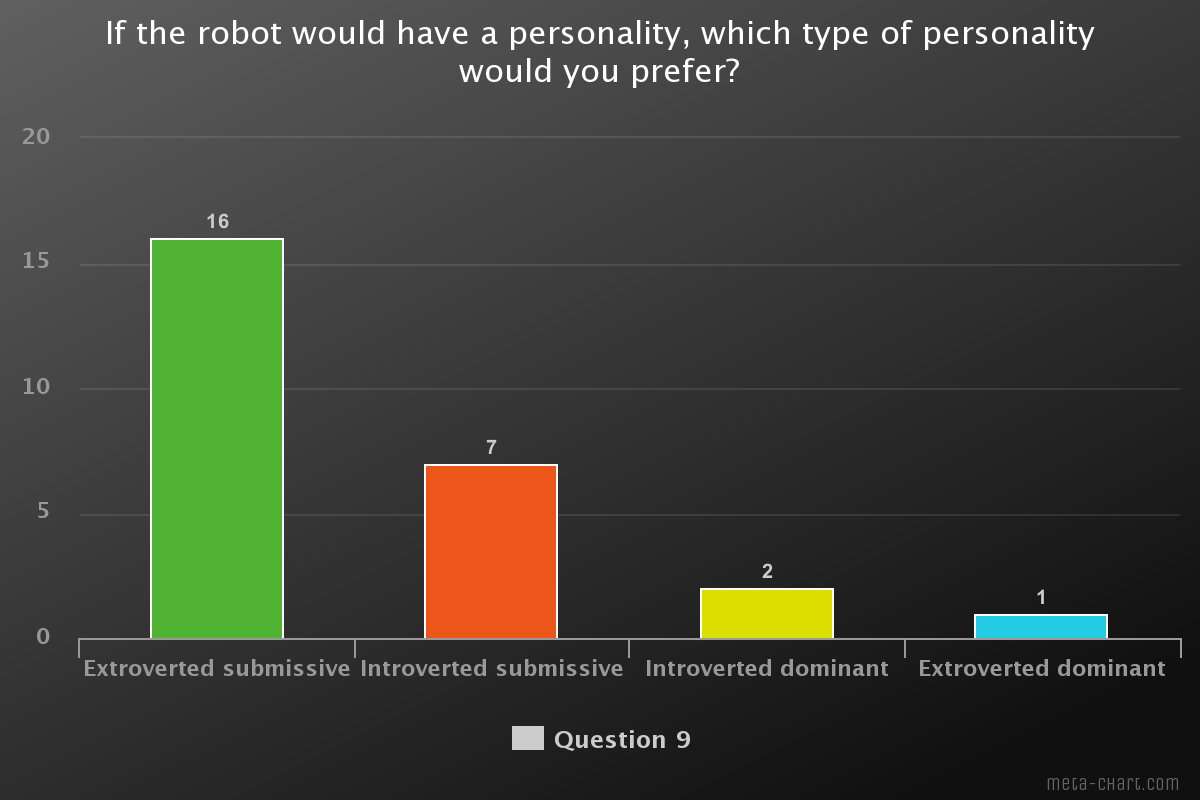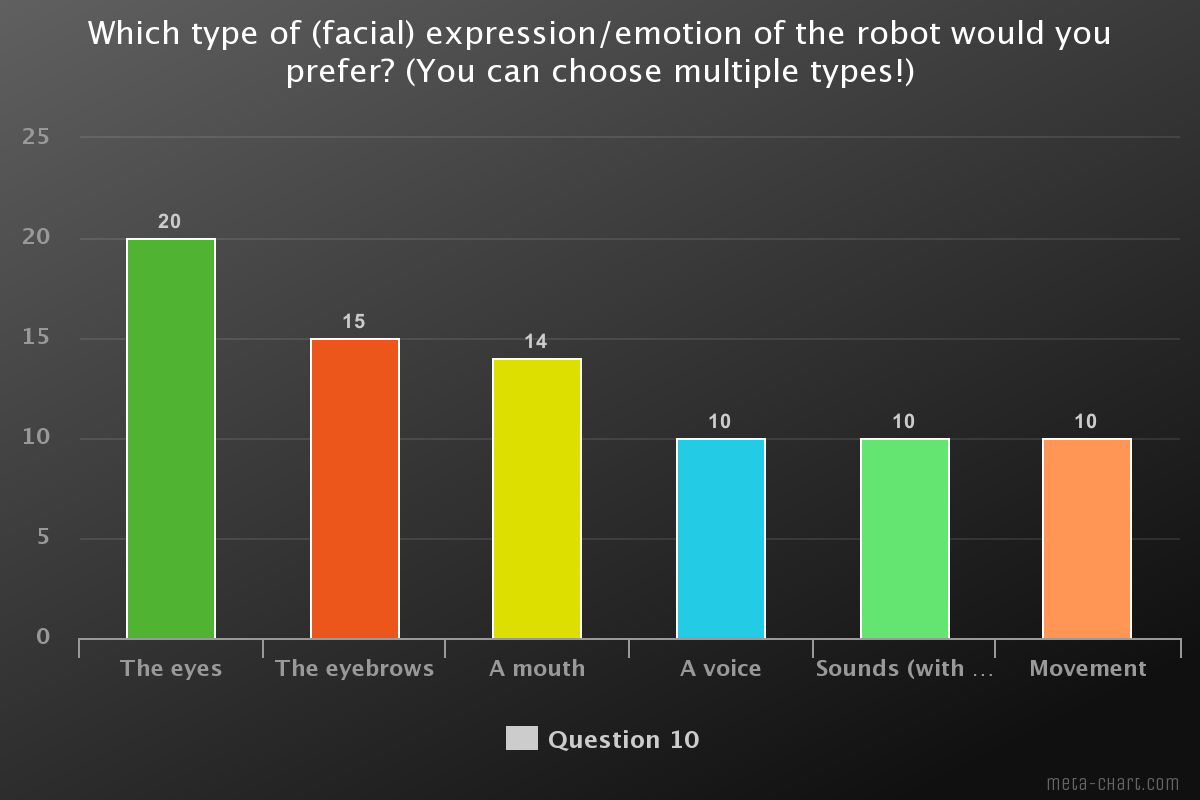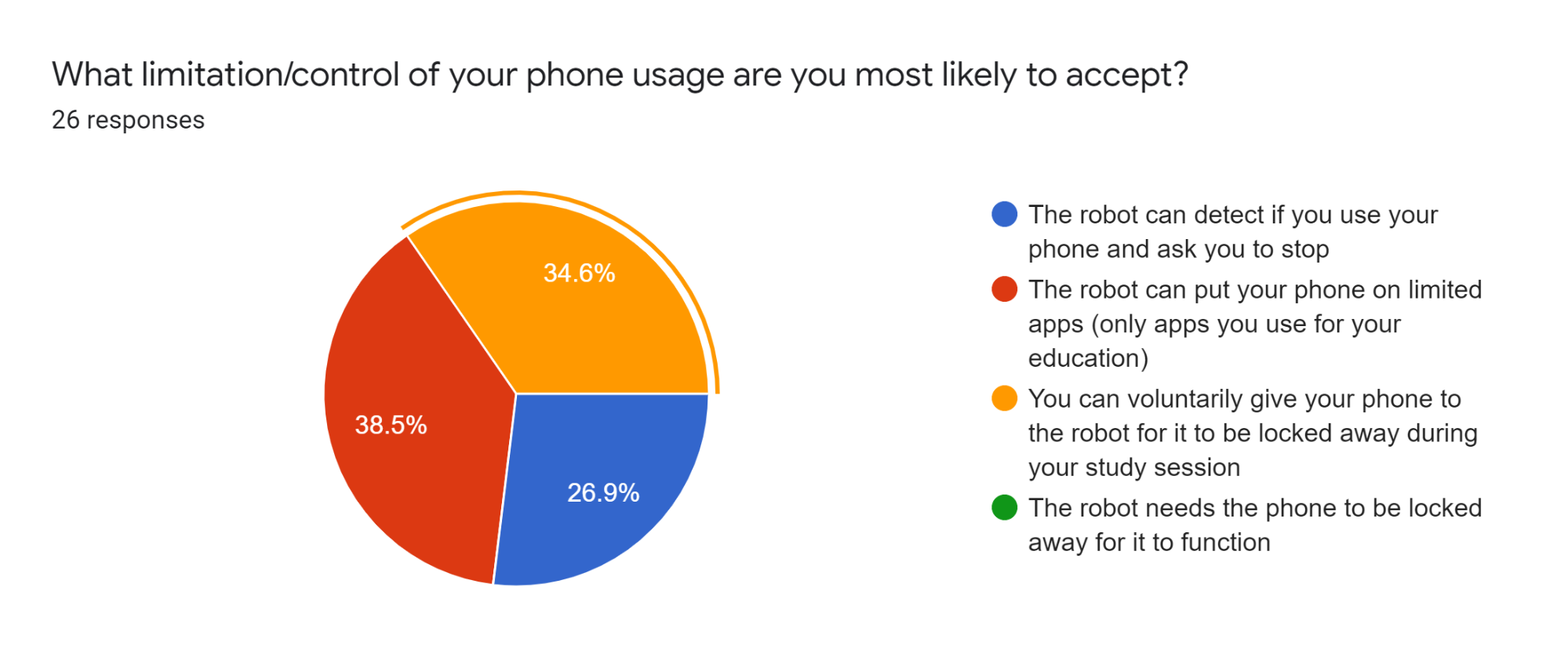PRE2020 3 Group2: Difference between revisions
| Line 53: | Line 53: | ||
==Use case== | ==Use case== | ||
Karl is 20 | Karl is 20 year old computer science student, he spends a lot of time working and studying on his laptop, lately he can't concentrate good enough on his work and is stuck in bad habits which makes it even harder to do so. | ||
Also due to COVID-19 he is spending a lot of time at home working alone which is making him a bit lonely. | Also due to COVID-19 he is spending a lot of time at home working alone which is making him a bit lonely. | ||
Karl heard about | Karl heard about Fibo and how it can help you follow good habits to increase concentration, and how it also gives the feeling of a social companion which makes you feel less lonely. | ||
After buying | After buying Fibo it helped him organize his work and study sessions better, he no longer gets absorbed in his work for hours on end, no with the help of Fibo he gets reminded to go for a walk every every 45-60 minutes, he also can better track how long he has been studying. | ||
He also don't get easily distracted by his phone which used to happen a lot, | He also don't get easily distracted by his phone which used to happen a lot, Fibo keeps tabs on phone usage and reminds Karl to go back to studying every time he gets distracted by his phone, it also encourages him that the study session is about to end and he can look at it afterwards in his break time. | ||
=Effect of colors on the brain= | =Effect of colors on the brain= | ||
Revision as of 13:25, 8 April 2021
Robot Desk Companion
Currently Working:No one
Group Members
| Name | Student ID | Department | Email address |
|---|---|---|---|
| Okke Rikmenspoel | 1376489 | Psychology and Technology | o.m.rikmenspoel@student.tue.nl |
| Christian Janssen | 1458167 | Psychology and Technology | c.h.f.janssen@student.tue.nl |
| Richard van Loon | 1238071 | Computer Science and Engineering | r.p.a.v.loon@student.tue.nl |
| Ahmad Alsarakbi | 1285874 | Computer Science and Engineering | a.alsarakbi@student.tue.nl |
| Isabel Kuipers | 1297325 | Industrial Design | i.e.kuipers@student.tue.nl |
Problem statement
Due to the COVID-19 pandemic, which started in early 2020, students had to work from home for longer periods of time. Different types of health problems occurred due to the work-from-home situation.[1] Students sit in front of their screen for many hours, Concentration is heavily impacted as well by students neglecting their health and not taking breaks or taking care of themselves. Also a phone is almost always in sight and nobody is telling them not to use it. Mobile phones can be distracting depending on what you do with them. Studies have shown that texting or social media use is highly distracting when studying but listening to music does not have to.[2]
Students do not need a nanny bot, however, a robot that guides them in the right direction would be very beneficial. This robot will be placed on the desk where the student works. The robot should not be too distracting (1). It should guide and motivate studying (2). And it should give friendly concentration reminders (3).
Objectives
- Guide studying. Our robot should help the student concentrate and fulfill his or her study time.
- It should not be too distracting. It is very important that our robot is not distracting since that would go against our main goal of helping the student study
- Make the robot amiable and persuasive in a non-aggressive way
USE Analysis
To make sure we are designing our robot to be as helpful as possible for our users we did a USE analysis of the various users, which will be discussed in this section.
User analysis
The main users of this robot will be students, and people with concentration problems. But mostly students with concentration problems. This robot can help people with getting work or study done, by making sure the users follow their schedule. The goal is to help the user make a schedule, because without a schedule the robot will not work, after that the robot will help the user to make sure they actually follow the schedule. A secondary effect of the robot is that the user will stay healthier by making sure the user gets enough movement, enough breaks and makes sure the user will not get too distracted by the phone.
Society analysis
Schools and Universities will profit from this product because the students that need help with studying and have concentration issues can be assigned with such a robot to make sure the school needs to do less work to make sure the students do not get concentration issues, and if they have them, to solve it. Also parents will profit from this because they will not have to worry about their kids not concentrating or being on their phone constantly because the robot makes sure their user studies and otherwise tries to get the user to do the work. This is also the case when someone works for a business and has trouble working at home or at office. The product can help them work and take breaks when needed.
Enterprise analysis
Businesses will also have profit from this product. Students are being helped to study, which means they on average will get higher grades which means more knowledge. This knowledge will help with work. Also when working the users will be helped and be more time effective. This will help the overall economy grow. Because of corona more and more people are working at home and it has proven to be effective. This product will make working at home even more effective.
Use case
Karl is 20 year old computer science student, he spends a lot of time working and studying on his laptop, lately he can't concentrate good enough on his work and is stuck in bad habits which makes it even harder to do so.
Also due to COVID-19 he is spending a lot of time at home working alone which is making him a bit lonely.
Karl heard about Fibo and how it can help you follow good habits to increase concentration, and how it also gives the feeling of a social companion which makes you feel less lonely.
After buying Fibo it helped him organize his work and study sessions better, he no longer gets absorbed in his work for hours on end, no with the help of Fibo he gets reminded to go for a walk every every 45-60 minutes, he also can better track how long he has been studying.
He also don't get easily distracted by his phone which used to happen a lot, Fibo keeps tabs on phone usage and reminds Karl to go back to studying every time he gets distracted by his phone, it also encourages him that the study session is about to end and he can look at it afterwards in his break time.
Effect of colors on the brain
We also did research on colors, research by shift [3] shows that low wavelength colors can improve efficiency and focus. For example the color green or blue. The color orange is a mood lifter. The color is welcoming, it promotes comfort and it also improves neural functioning. Theorists argue that an environment that is rich of orange colors, could increase oxygen levels in the brain. This could eventually lead to feeling invigorated. And makes you ready to get things done, for example school work. Ofcourse it is not only color but also brightness and saturation. When you want to boost energy, use a bright orange and when you want to relax go for mellow. The last color that is spoken of is blue. About blue they say that it makes people more productive. Blue is the best used to enhance learning. Lighter shades of blue look more friendly and lighter ones more somber. Many color psychologists would recommend to use orange. But some orange should be added. Too much blue could create a cold environment and a sense of detachment.
In the article How Does Color Affect Memory [4] we searched for new findings and confirmation of our information we already gathered. This article also says blue enhances knowledge, and orange promotes warmth, joy and balance. A study in University of British Columbia found that Red and Blue colors are best for enhancing cognitive skills. With detail oriented tasks, but also with memory retention, red was much better than blue. Red heightened their attention as well. In this article we also found that when studying you should restrict the use of colors to 2. This is the case with making notes but might also be of use for our project.
At last the site barker whittle [5] states that the color blue encourages better mind flow and performance. It makes sure that the surroundings are relaxing and are better to study or work in. Strong shades of blue support brain thought processes, and lighter shades of blue improve concentration. This article also talks about orange. Orange promotes focus concentration and creativity. The color encourages to be organized and keep your room organized. This will help being motivated to study or work. The brightness of orange is important. Strong brightness can stimulate but be distracting. Orange is the perfect color when you need energy. Green is also ideal for study rooms. It has a calming effect. It also relieves stress.
In conclusion, we want to use the effects of the colors optimally. This is why we will use blue in our robot to enhance the productivity and learning of the users. We will use the color orange in the breaks to make sure the users get organized, creative and more joy in their breaks. The last colors red and green might also be good to use for our robot. We might give it as an option in the robot to use those colors. But blue and orange will be the main 2 colors. Improving concentration is the main goal of our robot and according to this research blue should be able to help the users with this.
Emotions
https://www.psychologytoday.com/intl/blog/trust/201608/why-someones-disappointment-hurts-us-more-their-anger https://classroom.synonym.com/effects-disappointment-8285964.html https://www.psychologytoday.com/us/blog/high-octane-women/201210/emotions-are-contagious-choose-your-company-wisely
For our robot, we need to decide what emotion the robot will express when the user picks up their phone before being done with the study session. The emotions we are choosing from are, anger, disappointment and sadness. We compare the 3 emotions and try to answer the question, which emotion is best suited for our study robot. When someone is angry at you, most of the times we get forgiven by friends or family. So in a way we do not get what we deserve because we get forgiven. Or maybe the matter that made someone angry at you turns out not to be as bad as you thought. After this, we can move on and feel relief. But this is not the case with disappointment. When a person is disappointed, this person assure someone of a chilly calm. The disappointed person does not offer forgiveness. This is the big difference between being disappointed and being angry. We do not get this relief, also we wont get the reassurance that the matter did not matter.
QUOTE https://www.psychologytoday.com/intl/blog/trust/201608/why-someones-disappointment-hurts-us-more-their-anger : There is something depersonalizing, diminishing, and deflating about receiving disappointment rather than anger from our friends: It’s something we expect a parent or teacher to say to a wayward child.
To choose between anger and disappointment is hard. But between those 2 emotions we think disappointment is best fitted. The robot is not meant to be a friend for the users. It is meant to be nice for the users and to motivate them to study. But it will have minimal interactions with the user and it will have more of a teaching or coaching role then a friend role. This makes us think the best emotion between anger and disappointment is disappointment. We think disappointment will be a better motivator for the users to listen. We ourselves would also not like to study with a robot that is angry at us when we are not doing what is asked from us. We do however, need to watch out, because disappointment could have some unwanted effects when exposed to it for a longer time. When the users are continuously reminded that they do not meet the expectations of others (in this case the robot), this could threaten emotional and physical wellbeing. This is why we have to be careful with expressing too much disappointment. Sadness might be a solution to this. Because if the robot is disappointed, but not in the long term, it wont have such an emotional and physical effect on the users. This means that the robot has to start being disappointed. But when the user does not listen, the emotion changes into. This would mean the robot would look sad until the user puts their phone back in the robot. The users eventually probably feel guilty for leaving the robot sad, and will try making him happy. But emotions are contagious. And we want the users to feel as happy as they can during the studying. This is why we will make sure the robot will also reward the people. This means, when the phone is put into the robot, the robot has to be happy, and really make sure the user sees this. If the user becomes more happy when the robot is happy, the user will try to make the robot happier and thus listen better. So rewarding the user with joy is a good way to do this.
Scheduling and Motivation
For our robot, we felt it was necessary to research when a student should take breaks. Since most studying is done with a computer we found an interesting study titled ‘Supplementary breaks and Stretching Exercises for Data Entry Operators’.[6] This paper states that hourly 5 minute breaks decrease musculoskeletal discomfort and eyestrain. This same paper did not find any significant differences in doing stretching exercises or not. This paper is interesting to us because we can base the work schedule our robot makes for the student on this information. Advising the student to take a 5-minute break every hour would be good.
Another interesting paper written by Kenneth T. Strongman & Christopher D. B. Burt shows that most breaks are related to hunger or thirst.[7] This is helpful knowledge because we can tackle people taking breaks by indicating to drink a glass of water every half hour. Provided that they keep a bottle at their desk and don’t refill their glass every time because that would take time.
Other studies give examples of things to avoid while taking a break and things that are good to do while taking a break.[8] Things to avoid are snacking junk food or taking a nap. Sleeping during the daytime actually makes you more tired, slows you down and makes you less productive. Watching television, browsing the internet or playing video games are activities that do not aid efficiency. Another thing that does not help is drinking a lot of caffeine, it may seem to give you concentration but you will only crash down harder eventually.
There are activities that do help your efficiency and concentration. Taking a walk outside will give you fresh air and moving your body will help the blood flow. For that same reason, stretching can help release tension. Phoning a friend or having a conversation with anyone will help take your mind of the study material and helps relax your mind.
Robot description
This robot will be designed towards students and high-schoolers between the age of 12 and 25. It will be designed to stand on their desk and guide them during their studying time. The robot has a screen through which it can communicate with its owner. The robot will communicate on different kinds of things to help the student stay concentrated and healthy. It will show icons that will light up to remind the student to for instance drink water, sit up straight or not use their mobile phone. This will be done in a way that it does not distract the user when he/she is busy studying. Of course the robot should not inflict distractions upon the user. Reminding to drink water can be done every x amount of time. You could do the same for sitting up straight, but it would be ideal if the robot could detect the body posture of its user and work from there. Usage of a mobile phone is an interesting problem since there is a possibility to make a box where the user could put their phone into and put a time lock on it. We will research to what extent people are willing to hand in their mobile phone and let the robot restrict them on the use of it.
The robot will, as mentioned earlier, have a screen to communicate. Overall the robot should have a minimalistic design, to prevent possible distractions. Another function is an alarm, which the user can install him/herself. Because of this function, the robot can also remind the user when to go to sleep to get a sufficient amount of rest.
First Questionnaire results
| Question | Result 1 | Result 2 | Result 3 | Result 4 | Result 5 | Result 6 |
|---|---|---|---|---|---|---|
| If the robot would make sounds (with no words) during my studying, I would find that distracting. | 4.1 / 5 | |||||
| If the robot would show colored light(s) (without flickering) during my studying, I would find that distracting. | 2.9 / 5 | |||||
| If the robot would have a voice and occasionally speak during my studying, I would find that distracting. | 4.2 / 5 | |||||
| If the robot would vibrate occasionally during my studying, I would find that distracting. | 3.9 / 5 | |||||
| First choice: Type of interaction with the robot | Physical interaction = 11 (42.3%) | phone App = 4 (15.4%) | laptop app = 1 (3.8%) | voice command = 10 (38.5%) | ||
| Second choice: Type of interaction with the robot | Physical interaction = 7 (26.9%) | phone App = 10 (38.5%) | laptop app = 8 (30.8%) | voice command = 1 (3.8%) | ||
| Third choice: Type of interaction with the robot | Physical interaction = 5 (19.2%) | phone App = 8 (30.8%) | laptop app = 10 (38.5%) | voice command = 3 (11.5%) | ||
| If the robot would have a personality, which type of personality would you prefer? | Extroverted submissive = 16 (61.6%) | Introverted submissive = 7 (26.9%) | Introverted dominant = 2 (7.7%) | Extroverted dominant = 1 (3.8%) | ||
| Which type of (facial) expression/emotion of the robot would you prefer? (You can choose multiple types!) | The eyes = 20 (77%) | The eyebrows = 15 (57.7) | A mouth = 14 (53.9%) | A voice = 11 (42.3%) | Movement = 10 (38.5%) | Sounds = 10 (38.5%) |
| What limitation/control of your phone usage are you most likely to accept? | The robot can detect if you use your phone and ask you to stop = 7 (26.9%) | The robot can put your phone on limited apps = 10 (38.5%) | voluntarily give your phone to the robot = 9 (34.6%) | The robot needs the phone to be locked away for it to function = 0 (0%) | ||
| What limitation/control of your phone usage would you be least likely to accept? | The robot can detect if you use your phone and ask you to stop = 2 (7.7%) | The robot can put your phone on limited apps = 7 (26.9%) | voluntarily give your phone to the robot = 3 (11.5%) | The robot needs the phone to be locked away for it to function = 14 (53.8%) |
It is clear that many people would find sounds very distracting during their study since 80% is on the 4-5 scale and the over all average is over 4 / 5.
The results are varying for this question. 35% would not find it distracting but 27% would. This thus mainly depends on the personal preference of the user.
Here it is also very clear that speaking is considered as very distracting since it is high in the 4-5 meaning they strongly agree with the question.
Here the majority varies slightly. However, the majority is in the 4-5 scale meaning that this is considered distracting overall.
Overall lights seem to be the least distracting, it is important we can back this up with literature to be able to use it.
Looking at the chart there’s a majority for Physical interaction and voice commands, with a slightly higher percentage for physical interaction. A laptop application is favoured least.
It’s remarkable that this chart is significantly different from the other one. Here an app, physical interaction and laptop app are the majority. Physical interaction is preferred less than previous, however, voice commands have almost no votes.
Again the app on laptop and phone have the majority, with an app on the laptop slightly higher than previous.
Interesting is that in the suggestion there are people saying they don’t want another app or would find the phone distracting.
Looking at this chart it is obvious that an extroverted submissive robot is preferred. Meaning that the robot will not force the user and has a clear bubbly personality. Extroverted dominant and introverted dominant are clearly not preferred.
The eyes, eyebrows and a mouth are favoured the most. The rest of the options are in a tie, they have some significance but are not necessary. The eyes are clearly important. An unexpected result is the eyebrows, there aren’t many robots which use them.
The opinions are very divided on this topic. One obvious answer was not chosen, the robot needing the phone. We did not think that the lock away would be chosen this much. This shows that students feel the need to give up their phone for a while.
As seen previously, the robot needing the phone is preferred the least. Second is the limited apps option, which is contradicting the previous result. The robot asking if you can stop using the phone is most accepted. Again the unexpected result is the voluntary give away, apparently, people do accept this.
For us it is now important to look into what is important. Since the limited app is very contradictory this option can be left alone.
State-of-the-art
All of our research discussed min 25 papers
Isabel Human and robot interaction + already existing designs
Persuasive technologies
Planning
Approach and milestones
- how will we solve the problem?
- milestones per week
Week 1 Define functions needed Research functions and design aspects Week 2 Questionnaire for user input Sketch proposed design Week 3 Analyse questionnaire Sketch detailed design Create base simulation robot Week 4 Finalize simulation Start prototyping Week 5
Week 6 Finish prototype Week 7 Final video
Week 8 Final wiki
Planning table
-who does what in which week etc
-when is what done
| Week | Okke Rikmenspoel | Christian Janssen | Richard van Loon | Ahmad Alsarakbi | Isabel Kuipers |
|---|---|---|---|---|---|
| Week1 | |||||
| Week2 | |||||
| Week3 | robot description and research function | looking into simulation tools | looking into simulation tools | compile research and use cases | spread the questionnaire and look into the scenario |
| Week4 | Research scheduling and its effect on motivation | weebots simulation aspects | weebots simulation aspects | weebots simulation aspects | design choices of the robot interactions |
| Week5 | |||||
| Week6 | |||||
| Week7 | |||||
| Week8 |
Worklog
Week 1
| Name | Total [h] | Break-down |
|---|---|---|
| Okke Rikmenspoel | 4.5 | Meetings (3h), Research (1.5h) |
| Christian Janssen | 5 | Meetings (3h), Research (2h) |
| Richard van Loon | 5 | Meetings (3h), Research (2h) |
| Ahmad Alsarakbi | 5 | Meetings (3h), Research (2h) |
| Isabel Kuipers |
Week 2
| Name | Total [h] | Break-down |
|---|---|---|
| Okke Rikmenspoel | 4.5 | Meetings (2.5h), Research (2h) |
| Christian Janssen | 6.5 | Meetings (4h), Research (2h), Wiki (0.5h) |
| Richard van Loon | 5 | Meetings (4h), Research (0.5h), Planning (0.5h) |
| Ahmad Alsarakbi | 6 | Meetings (4h), Research (1h), Questionnaire (1h) |
| Isabel Kuipers | 7 | Research (1,5h), Questionnaire (2,5h), Sketch (1h), Wiki (2h), Meetings (4h) |
Week 3
| Name | Total [h] | Break-down |
|---|---|---|
| Okke Rikmenspoel | 4 | Robot description (2h), Meetings (2h) |
| Christian Janssen | ||
| Richard van Loon | ||
| Ahmad Alsarakbi | ||
| Isabel Kuipers |
Deliverables
- wiki page
- simulated robot
- prototype (if possible)
- presentation
After the plan
- Researched functions chosen
- Questionnaire + results
- Design sketch + all the aspects explained
- Simulation explained
- Prototype shown and explained
References
- ↑ Gualano, M. R., Lo Moro, G., Voglino, G., Bert, F., & Siliquini, R. (2020). Effects of COVID-19 lockdown on mental health and sleep disturbances in Italy. International Journal of Environmental Research and Public Health, 17(13), 1–13.
- ↑ David, P., Kim, J. H., Brickman, J. S., Ran, W., & Curtis, C. M. (2015). Mobile phone distraction while studying. New Media and Society, 17(10), 1661–1679.
- ↑ how do colors influence learning
- ↑ How Does Color Affect Memory
- ↑ barker whittle
- ↑ [Galinsky, T., Swanson, N., Sauter, S., Dunkin, R., Hurrell, J., & Schleifer, L. (2007). Supplementary Breaks and Stretching Exercises for Data Entry Operators : A Follow-Up Field Study. 527, 519–527. https://doi.org/10.1002/ajim.20472]
- ↑ [Strongman, K. T., & Burt, C. D. B. (2000). Taking breaks from work: An exploratory inquiry. Journal of Psychology: Interdisciplinary and Applied, 134(3), 229–242. https://doi.org/10.1080/00223980009600864]
- ↑ [Mackey, K. E. (1999). Give Me a Break. IEEE Software, 16(1), 26–27. https://doi.org/10.1109/MS.1999.744562]
